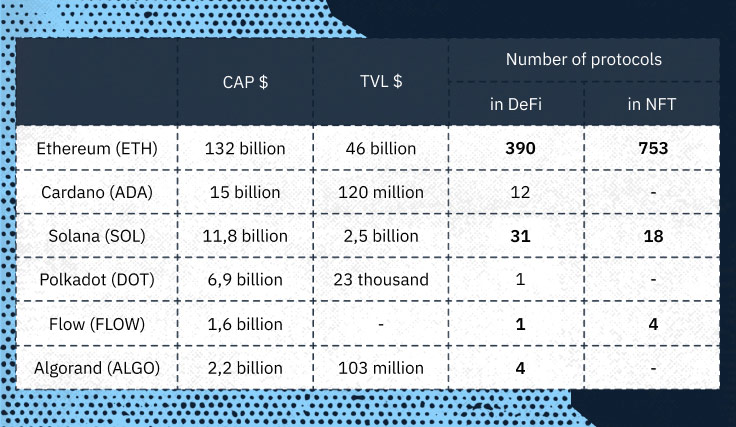The Ethereum blockchain has grown in popularity in the crypto sphere because it became the first universal platform to work with decentralized apps. Using Ethereum as a basis, programmers can develop decentralized applications in Solidity without having to build their own network. Thanks to its innovative approach, Ethereum became the fulcrum for the development of dApps back in 2015, and seven years later, it dominates the Web 3.0 sphere.
However, the Ethereum network has several global problems. The main one is low bandwidth. Basically, the number of transactions made by the network is limited by block capacity. This is the key obstacle for Ethereum scaling.
Moreover, the more popularity the Ethereum network received, the higher the transactions on its network became. The London Hard Fork increased the maximum block capacity to 1,428 transactions and the gas limit per transaction. This slightly lowered fees, but user requests to the network generally remain unsatisfied.
Against this background, new players periodically enter the blockchain sphere, each claiming Ethereum’s laurels by offering low fees and a scalable framework for Web 3.0 apps. And since Ethereum was the first, all potential competitors have been dubbed “killers.”
New networks are often indeed more cost-effective and energy-efficient than Ethereum, but the biggest altcoin still holds the lead. That’s why it’s the biggest. So, according to CoinMarketCap, DappRadar, CryptoSlam!, and DefiLlama (here and below, the information is based on their data), the Ethereum network’s main indicators, as of July 8, 2022, are:
- Project capitalization: $151 billion;
- Number of blockchain-based DeFi protocols: 511;
- Number of blockchain-based NFT collections: 5,140;
- Market share in the NFT sector: 74.35%.
- TVL (Total Value Locked) in accounts of blockchain-based DeFi projects: $49 billion;
- DeFi dominance: 63.19%.
Competitors have especially stepped up due to Ethereum’s transition to the PoS algorithm, which is designed to solve the network’s main problems. This is evidenced by the increased activity of these networks’ developers.
Let’s take a look at what benefits the killers have and how it affects Ethereum’s popularity.
Cardano

The blockchain platform Cardano was created by Ethereum co-founder Charles Hoskinson in 2017. The project takes a scientific approach, the IOHK (Input Output Hong Kong) research lab works closely with the scientific community to review its developments.
Cardano uses the Ouroboros consensus mechanism, a PoS chain protocol that enables extremely fast transaction processing. Quick and cheap transactions are what put Cardano among the Ethereum killers.
Project capitalization: $16.1 billion.
TVL: $124.3 million.
Number of blockchain-based DeFi protocols: 12.
Number of blockchain-based NFT collections: over 100 (according to Cardano Cube).
Solana

Solana, a fast and easily scalable blockchain project, saw the light of day in 2020 and could be a major threat to Ethereum. Solana’s innovative Proof-of-History consensus mechanism increases transaction bandwidth by tens of thousands of times, compared to PoW or PoS-based networks.
However, Solana’s constant failures, which lead to a complete blockchain shutdown, negatively impact the SOL altcoin value and the project’s popularity in the crypto community.
At this stage of Solana’s development, it wouldn’t be right to consider it a killer because this supposed competition actually turns out to be more like an auxiliary feature when examined in detail. By providing cheap and fast transactions, Solana boosts global activity in the blockchain sector and the value of Web 3.0, thereby contributing to the development and popularization of the pioneering network, Ethereum. Some well-known platforms, such as Audius, a music streaming platform, run on two blockchains that complement each other and enhance the user experience.
Project capitalization: $13 billion
TVL: $2.76 billion.
Number of blockchain-based DeFi protocols: 72.
Number of blockchain-based NFT collections: 58.
Polkadot

Polkadot, released in 2020, joined the list of Ethereum killers thanks to Parachain technology, which allows for the use of parallel blockchain networks. Due to this, Polkadot has a large scalability resource and can process about a thousand transactions per second.
The Nominated Proof-of-Stake (NPoS) consensus algorithm used by Polkadot speeds up the transaction validation process and reduces network fees.
A key reason to call Polkadot a potential “killer” is Ethereum’s scalability issues, however, the transition to Ethereum 2.0 should soon solve that problem. Then, Polkadot developers will have to look for other competitive advantages to fight for, such as developing the NFT segment, which at the moment is only implemented in the Kusama Network (KSM) testnet.
Project capitalization: $7.1 billion.
TVL: $24,000.
Number of blockchain-based DeFi protocols: 1.
Flow

The Flow blockchain network is designed to support NFTs and the creation of decentralized games based on Proof-of-Stake. Flow’s unique multi-node architecture solves scalability problems by providing low-cost and fast transactions.
Ethereum’s problems limit its use for developing high-performance apps, while Flow allows for the creation of high-quality blockchain games like Zeedz, Matrix World, Solitaire Blitz, or The Football Club, which have good gameplay and graphics. Generally speaking, the popularity of blockchain games puts Flow in the ranks of potential Ethereum killers.
Project capitalization: $1.7 billion.
Number of blockchain-based DeFi protocols: 1.
Number of blockchain-based NFT collections: 2.
Number of protocol-based blockchain games: 7.
Algorand

The platform was launched in 2019 by one of the greatest cryptographers of our time, Turing Award winner Silvio Micali.
Algorand’s main difference from Ethereum is that it runs on the Pure Proof-of-Stake algorithm, which allows it to process thousands of transactions per second. The Algorand network doesn’t require asset locking from validators to achieve consensus, distinguishing it from other PoS-based blockchains.
Algorand can be considered the best contender for the Ethereum killer title because project developers were able to find the best solution to the scalability problem without sacrificing security and decentralization.
Project capitalization: $2.2 billion.
TVL: $110 million.
Number of blockchain-based DeFi protocols: 7.

Prospects for Ethereum Killers

The popularity of Ethereum killers grows only because the network faces problems. Therefore, Ethereum developers are likely to “kill themselves” if they make mistakes when merging testnets with Beacon Chain.
There is an opinion that if Ethereum stops using the PoW algorithm, its popularity may decrease since the blockchain’s performance will no longer need miners. One can imagine the dissatisfaction of the latter, who have invested impressive sums in buying the necessary equipment that will soon become useless for mining coins in the Ethereum network. However, ETH miners are unlikely to give up the blockchain, even despite such “betrayal,” and the mining equipment based on the Ethash algorithm can be used to mine dozens of other cryptocurrencies.
Also, it’s assumed that in case of a successful transition to Ethereum 2.0, the project will simply “destroy” the competitors. But this assumption can be classified as unrealistic. The thing is that the prospect of a monopoly left the chat long ago, and diversity in the cryptocurrency market gives birth to healthy competition and stimulates projects to develop, offering new solutions for the digital economy.
Thanks to cross-chain bridges, all blockchains are likely to be interconnected in the future, so the main issue will only be the market share occupied. Therefore, Ethereum’s goal will be to maintain its leadership after the transition to 2.0, while its killers will try to “bite off” a larger share and not give up their positions. Those who succeed will occupy their niches, where they will offer technical solutions for specific user requirements.










